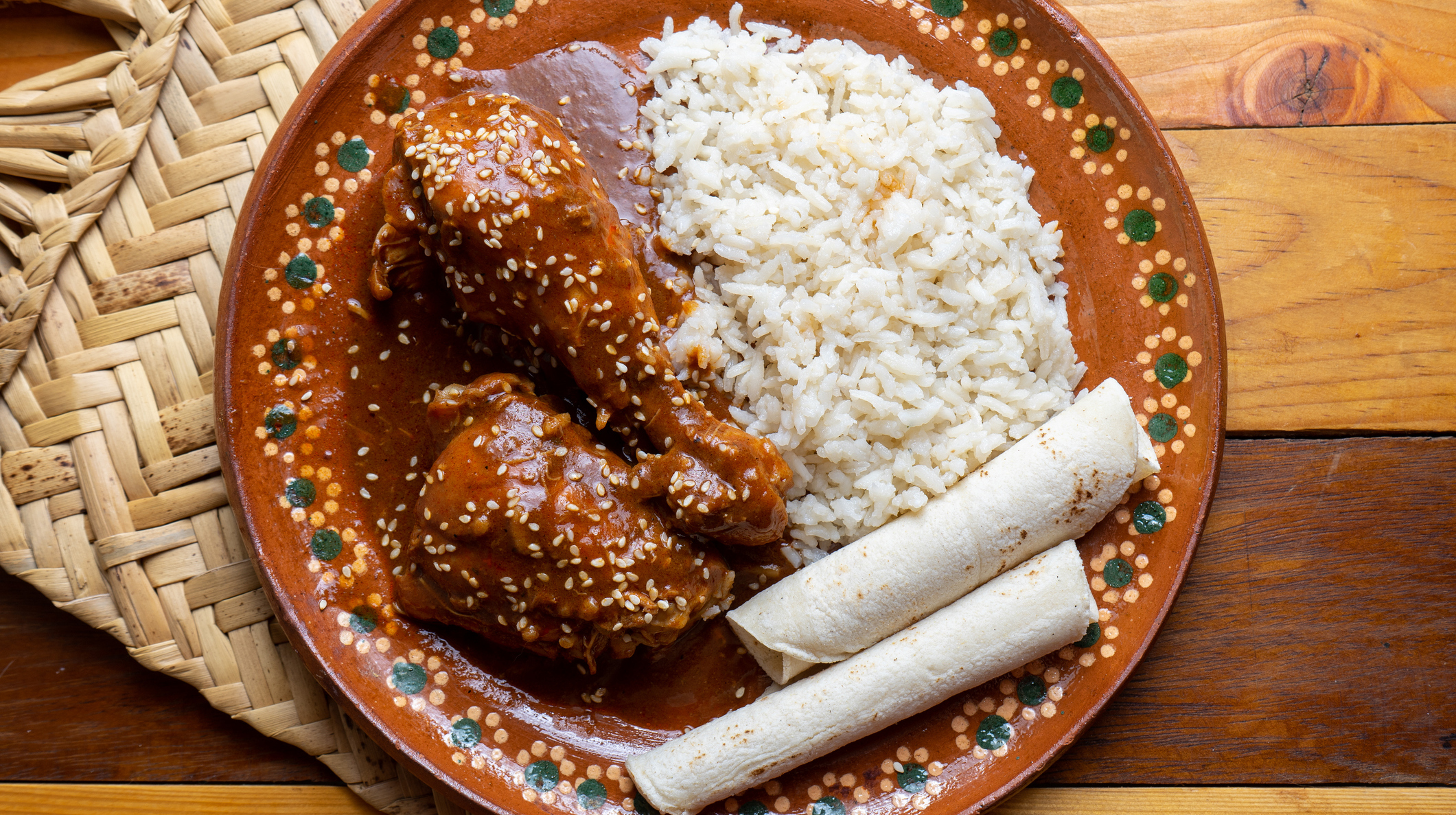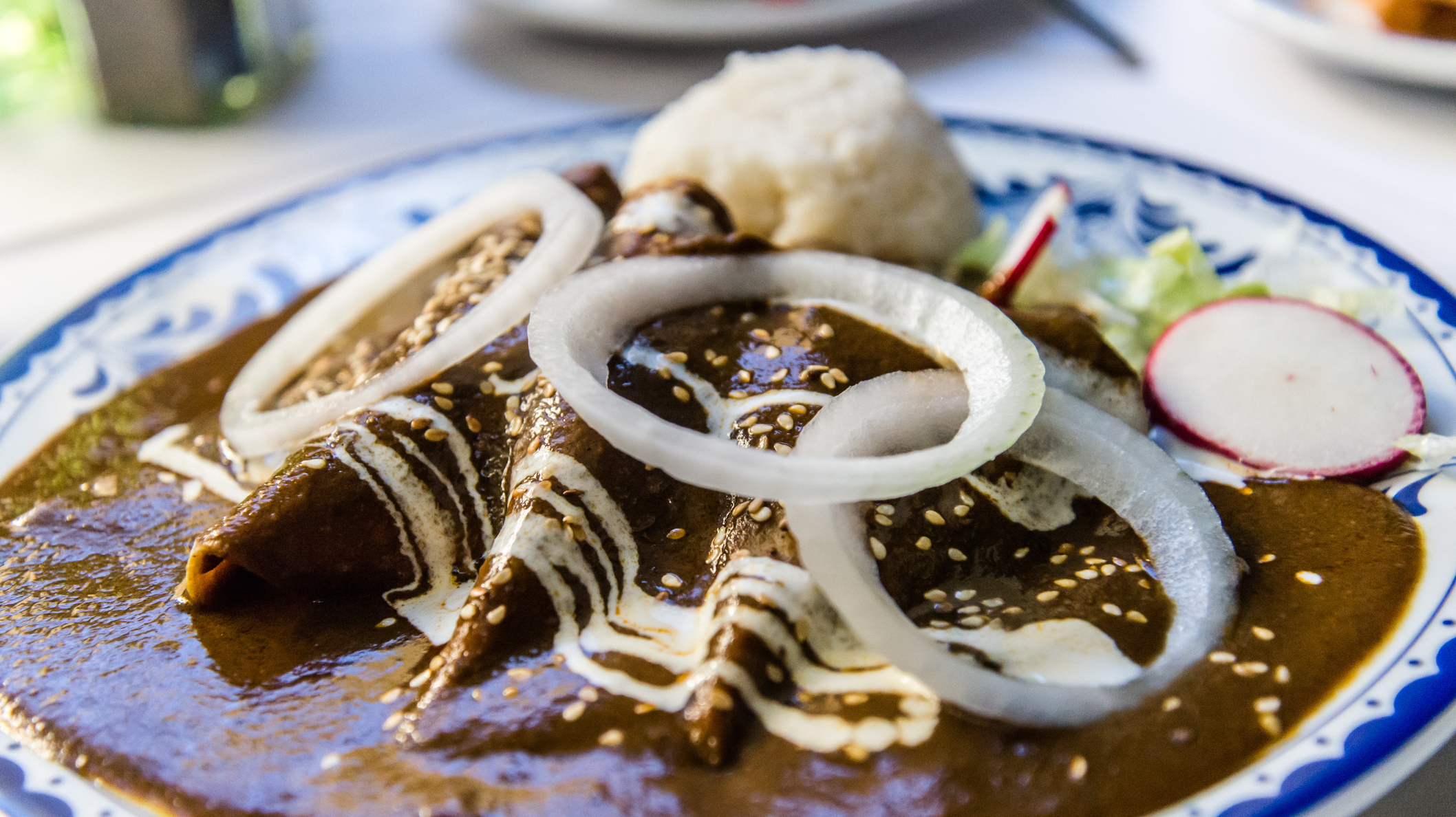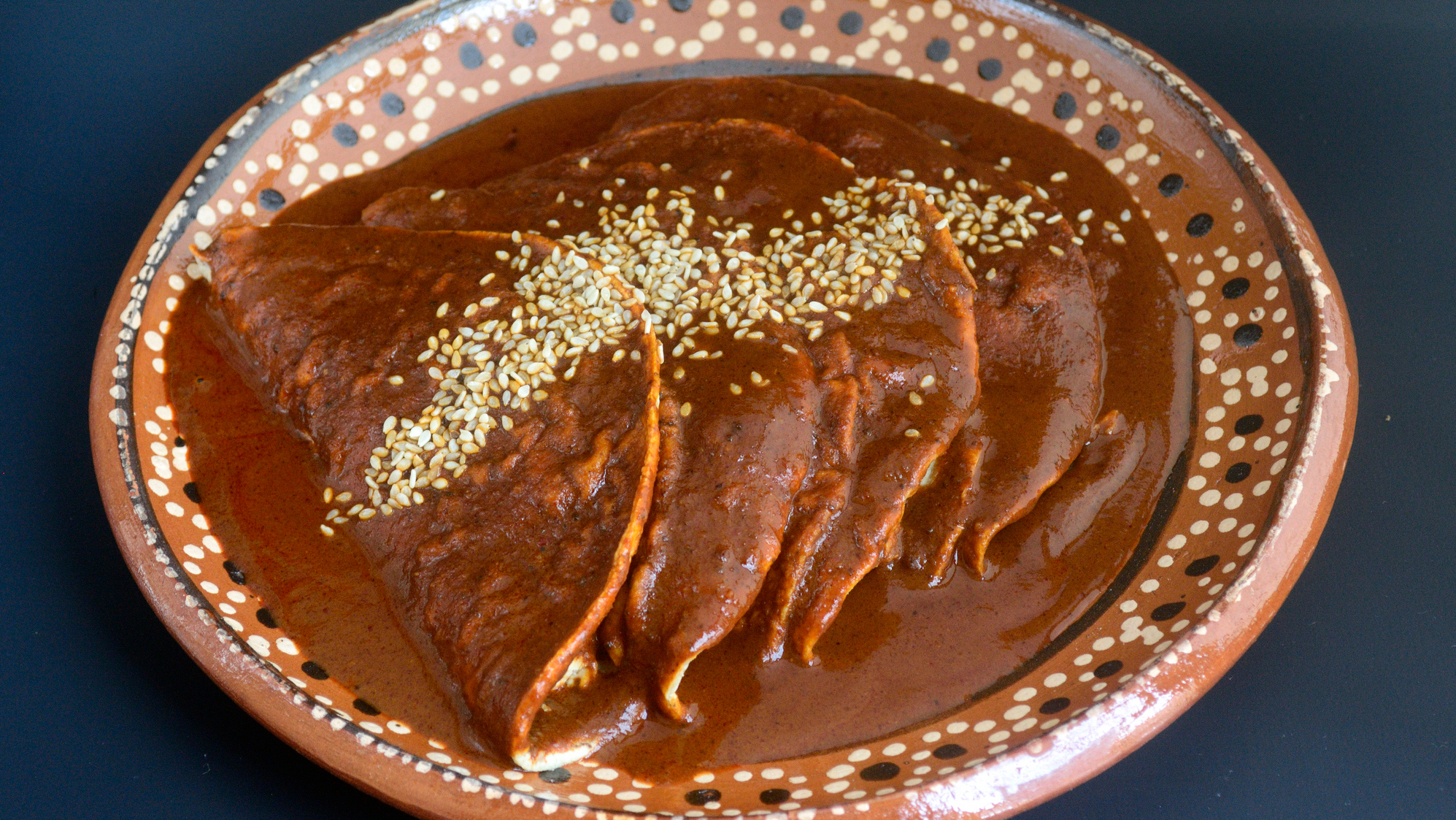Holy Molé: A Beginner's Guide To Mexico's Heaven-Sent Sauce
In Mexican families, recipes are heirlooms being passed down from one generation to the next—and a great molé recipe is among the most treasured of gifts. In my family, my aunt is in possession of that coveted molé recipe and all I have is the bitter truth that she will likely never share it with me. That bitterness may be just enough to drive me to consider legal action in order to attain it someday, so I hope she's reading this.
Molé is commonly referred to as Mexico's national sauce. In fact, renowned Mexican writer/philosopher Alfonso Reyes Ochoa once said that "Molé is the pièce de resistance of our cuisine, the touchstone of cooking and eating, and to ignore molé could almost be considered an act of treason against the nation." It should go without saying that molé is more than just a sauce; it's a source of pride.
What do we mean by molé?
In its simplest form, molé is a rich sauce that contains four distinct groups of ingredients—chiles, sour ingredients (such as tomatillos), sweet ingredients (fruit and sugar), and thickeners (nuts or tortillas)—with chicken or turkey being the favored choice of meat. The word molé comes from the Nahuatl word, mōlli, which means sauce. Though to view molé as simply a sauce would be a disservice that would fail to underscore its complexity and range. Molé is about layering flavors; some variations are made with more than 30 ingredients. Unlike other sauces that serve as an accompaniment to proteins or rice, molé is always the centerpiece.
Where did molé come from?
Puebla and Oaxaca, the two bordering states located in the central highlands of Mexico, are the most closely associated with the origins of molé. Other states throughout Mexico have their own variations as well; the community of San Pedro Actopan even has its own molé festival that's been running since 1977. Of the fewer than 9,000 inhabitants of that community, it's said that almost 92 percent of the population makes a living related to the preparation and sale of the sauce.
Mexican folklore tells two tales as to the creation of the sauce. One states that 16th-century nuns, during what seems like a really intense prayer session, had a visit from an inspirational angel. The nuns then used the ingredients they had available—more than 20 of them—to create a dish for the visiting Archbishop. Needless to say, the dish was a hit and became known as molé.
The other tale goes back to pre-hispanic and, obviously, pre-Google fact-checking times. Legend has it that the Aztec emperor, Moctezuma, served molé to Hernan Cortez and his gang of conquistadors on the false belief that they were gods.
Regardless of what you believe, there's a divinity to this sauce that can't be left unstated.
Oaxacan molés
Oaxaca is the culinary mecca of Mexico, so it's no surprise that the most variations come from the region. There are seven distinct molés from Oaxaca, mostly named for colors:
- Negro: Negro is one of the most common molés. This is an extremely dark (hence its name), bitter chocolate sauce that pours thick with an equal amount of sweet and savory flavor to it. Molé negro recipes call for day-old bread as a thickener, and the sauce gives off an intoxicating aroma from the cloves, nutmeg, and allspice.
- Coloradito: Coloradito, which means "little red," is on the sweeter side of the flavor spectrum from the raisins used in the sauce. Some recipes call for plantains to be used as thickener in the sauce, which also lends some residual sweetness. This molé relies solely on ancho chile and calls for a healthy amount of garlic.
- Verde: Made with pumpkin seeds, cilantro, and jalapenos, molé verde (green) is bright with an underlying tartness from tomatillos. Unlike other molés, verde does not use any dry chiles.
- Rojo: Very similar to the base ingredients as negro, rojo (red) is an amplified version of negro with a sweeter and spicier flavor profile. Rojo calls for more dried chiles—ancho, pasilla, mulato—and less chocolate.
- Amarillo: Unlike other moles, amarillo (yellow) doesn't use any chocolate. The sauce has a thinner consistency than other molés, more like a viscous broth, as it isn't reduced as long as other varieties. There's a slight corny flavor to amarillo since traditional recipes do call for masa harina, a dried corn flour, to be incorporated into this molé. There's a meaty flavor from the cumin and the aroma comes courtesy of the dried oregano, allspice, and cinnamon.
- Chichilo: Recipes for chichilo start with a rich, homemade beef stock. Chichilo also calls for the use of the chilhuacle, a small chile that is not only indigenous to Oaxaca, but has been cultivated for over 6,000 years. The chile is also used in other molés, but it's the main one in chichilo alongside guajillo chile. Chichilo doesn't call for chocolate but it does have aromatic herbs such as marjoram, thyme, and oregano.
- Manchamantel: The literal translation of manchamantel is "table-cloth staining." Traditional manchamantel molé is made with chorizo, so the red grease from the chorizo, ancho chiles, and tomatoes all add up to a vibrant red sauce. This sauce also is made with pineapple, so it leaves the sauce a lot sweeter than its other molé counterparts.
Other molés
There are countless molés in Mexico. Many of the molés in one region are the same as those in other regions with the difference being an indigenous ingredient or two. Below are some of the most common molés I've encountered:
Poblano: Chances are if you had a molé in an American restaurant it was a poblano molé. Poblano is very similar to molé negro, the major difference being that the negro uses chilhuacle negro chiles. Poblano mole is considered one of Mexico's national dishes.
Amarillito: Outside of Oaxaca, molé amarillio is referred to as amarallito. Amarallito refers to a variety of molés that get its color from yellow-ish, costeño chiles which are relatives of guajillo chiles. Where guajillo chiles tend to be mild and sweet, costeño chiles have a richer, spicier flavor.
Prieto: Molé prieto is from the state of Tlaxcala and originated as a ritual meal for Toci, the goddess of textiles and health. This pre-hispanic molé's original ingredients were corn, venison and/or turkey. After Spanish colonization, pork became the preferred meat. Chipotle is the main chile molé prieto, so the sauce has a lingering, smokey flavor.
Ranchero: This is one of the simplest molés to make. Ranchero molé usually calls for only one type of chile, so it's a milder sauce. In some regions of Mexico, ranchero is cooked with pulled beef; in other regions the beef is substituted with pork. Ranchero is also used in tamales in the state of Jalisco.
Rosa: Rosa molé is a pretty pink sauce that gets its color from roasted beets, but packs quite a sting from the serrano and jalapeno in the recipe. Rosa comes from Taxco in the state of Guerrero.
Pipián: Pipián is a type of molé made primarily with pumpkin or squash seeds (pepitas, hence the name) instead of other nuts like peanuts, pine nuts, or sesame seeds, which are common in other molés. Green pipian has tomatillo, onions, and pepitas to give the pipian an earthy flavor. There is also a red pipian that is made with tomatoes in place of the green tomatillos.
Almendrado: This is a popular mole from San Pedro Actopan. It's made with almonds and various other nuts, but it has a distinct sweetness from the various fruits included in its recipe, most commonly apple.
Molé transcends beyond just the culinary, becoming the centerpiece of and inspiration for festivals and celebrations in both Mexico and the U.S. If you need a quick molé fix but can't get down to Mexico on a whim because your pilot and private jet happen to be imaginary, take a trip down to your local Mexican supermercado where you should be able to find some respectable options. Goya always makes solid Mexican food products, but Dona Maria is my go-to molé paste if I don't have all day to make my molé from scratch. The original is solid, and their pipian and verde are also good options. Beware, this is mole paste, so it takes some elbow grease and time to get the molé thoroughly mixed. If you don't have time, you're in luck: Dona Maria also makes a ready-to-serve option.
Unless you have a lot of time, patience, and commitment, molé-making might be best left best to the professionals. But if you're feeling adventurous, you should take a crack at making a molé that you feel would best appeal to your preferred flavors. If turns out tasty, share it with your friends, family, and co-workers—a good molé is something to be revered.


